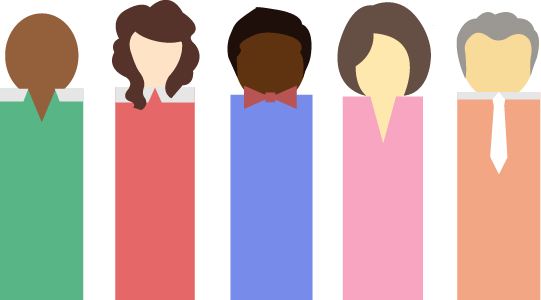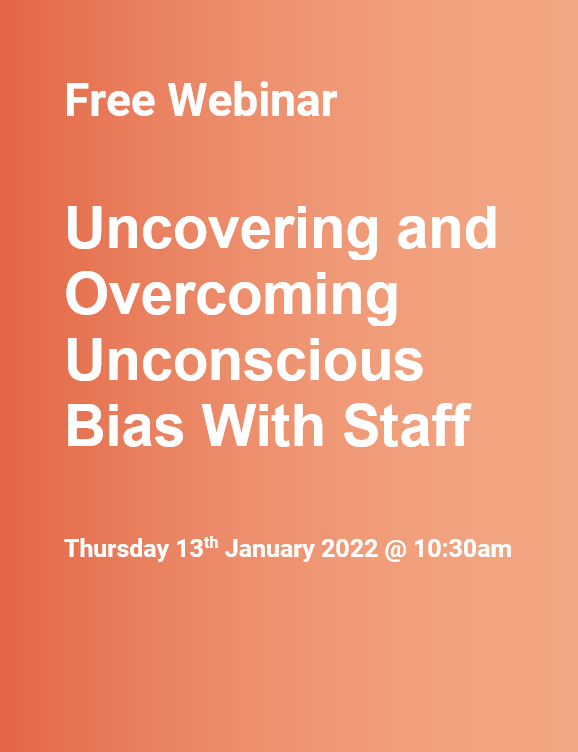Tuesday 11 Jan 2022 Article
The TakeawayThe Dangers of Ignoring Unconscious Bias
Uncovering and Overcoming Unconscious Bias With Staff
Part 1
#Leadership #EmpowerYourStaff #WorkRelationships #Equality #FreeWebinar #PersonalDevelopment
The perfectly matched resource for this article...
[Free Webinar] Uncovering and Overcoming Unconscious Bias With Staff
Sign up to our free Uncovering and Overcoming Unconscious Bias With Staff by clicking the button below!
Register for free!Playing catchup?
The Dangers of Ignoring Unconscious Bias
The human brain unconsciously processes 11 million pieces of information per second, but only consciously processes 40.
With this, it’s no surprise that we form a lot of our opinions and views subconsciously; this is known as unconscious bias.
In this article, we explore the meaning of unconscious bias, what it can look like at work, and the dangers of not addressing it.
What is Unconscious Bias and How Common is it?
Over many years of evolution, our brains have developed the cognitive ability to create mental short-cuts based on past experiences to help us quickly navigate the huge amounts of information that we process every second.
Whilst this function can be useful for quick decision-making, especially in crisis, it can also lead to implicit/unconscious bias.
The term implicit bias, also known as unconscious bias, was coined back in 1995 by psychologists Mahzarin Banaji and Anthony Greenwald and refers to “attitudes or stereotypes that affect our understanding, actions, and decisions in an unconscious way”.
Put simply, every time we make a decision, our life experiences, background, and cultural values (all of which influence our unconscious biases) influence the decision.

In 1998, a team of social psychologists at the University of Washington and Yale found that unconscious bias is present in over 90% of people, making it extremely common.
What Does Unconscious Bias Look Like at Work?
Unconscious bias is a major contributor to the lack of diversity in workplaces and it can present and manifest itself in many ways. These are 7 of the most common types of bias at work:
- Affinity Bias
The preference for people similar to ourselves because we find them relatable. Similarities could include ethnicity, work experience, gender, geographical location, socioeconomic status and more. For example, hiring someone purely because you went to school together. - Attribution Bias
Putting others’ success down to luck and their failures down to lack of ability, but putting own success down to our skills and our failures down to bad luck. For example, putting a sales rep winning a large business deal down to luck. - Beauty Bias
Basing an opinion of someone based on their appearance. This can also link to other types of bias e.g. ethnicity, culture, or socioeconomic status. For example, not hiring someone because you didn’t like their outfit, even though it was suitable work attire. - Confirmation Bias
Seeking and picking out evidence that validates our preconceived opinion of someone, whilst ignoring the evidence that contradicts our opinion. For example, thinking a candidate wouldn’t be suitable for the role just because they are older, so trying to find evidence that supports that despite the candidate having all of the right qualifications, skills, and experience. - Contrast Effect
Comparing and contrasting people against others instead of looking at their individual skills, talents etc. For example, two employees beat their sales targets but only one of them gets raised as they made slightly more sales than the other employee. - Gender Bias
Having a preference for one gender over others - this is actually one of the most talked about biases at work. For example, hiring a female candidate over a male candidate even though they are equally as suitable for the role. - Halo and Horns Effect
The Halo Effect means focusing on one particularly good aspect of a person, letting that ‘halo’ outshine any negative traits. Opposite to the Halo Effect, the Horns Effect means focusing on one negative aspect of a person, letting it overshadow their positive traits and skills. For example, seeing an employee as a poor performer because of one mistake they made, even though their work is otherwise exceptional. - Ageism
Ageism is the belief that a person’s age determines their skills or abilities, often thinking that people of a certain age are more/less competent than those younger/older. For example, assuming that an older candidate won’t be good with technology compared to a younger candidate, and therefore hiring the younger candidate even if they have less experience or qualifications.
What Are the Dangers of Ignoring Bias?
Unconscious bias can easily creep into our decisions and encounters with others, especially if we aren’t aware of it. But what actually are the dangers of not addressing unconscious bias in the workplace?
{{ADVERT}}
Firstly, unconscious bias can have a big impact on recruitment and can cause us to hire the wrong person, or to hire someone for the wrong reasons. For example, someone that worked in a start-up technology company may hire Candidate A over Candidate B because they are male, younger than Candidate B, share the same hobbies as the recruiter, and they live in the same town. This would be an example of gender bias, affinity bias and ageism. This could lead to the chosen candidate being under-qualified and not suitable for the role, meaning they are likely to under-perform and make it harder for the organisation to achieve its goals.
Unconscious bias can have a similar impact on promotions; employees may be promoted for one thing they did that their manager really liked, even if their other skills aren’t quite where they need to be to be suitable for the promotion. This would be an example of the Halo Effect.
Team morale and cohesion can also suffer because of unconscious bias. Whether it’s remarks being made or certain employees being left out, this can decrease employee satisfaction which is likely to, in turn, increase absenteeism and staff turnover.
In severe cases, strong unconscious preferential biases can lead to workplace discrimination, bullying, harrassment, and a generally non-inclusive environment. This can put businesses at risk of their reputation being damaged, which can cause both potential employees and customers to look elsewhere, costing the business good talent and revenue.
Ultimately, unconscious bias is natural but, for the good of the individual, the team, and the organisation, it needs to be uncovered and addressed.
How to Uncover and Overcome Unconscious Bias with Staff
At 10:30am GMT on Thursday 13th January 2022, we are running a free webinar all about ‘Uncovering and Overcoming Unconscious Bias With Staff’.
This webinar will be hosted by Kerry Clarkson, one of our expert trainers, and will help you understand how to help others uncover and overcome their unconscious biases and consider how this might be useful for the organisation.
To sign up for this free webinar, click here or click the button below.
---
Until next time...
[Free Webinar] Uncovering and Overcoming Unconscious Bias With Staff
Sign up to our free Uncovering and Overcoming Unconscious Bias With Staff by clicking the button below!
Register for free!Missed an article?
More from Uncovering and Overcoming Unconscious Bias With Staff
